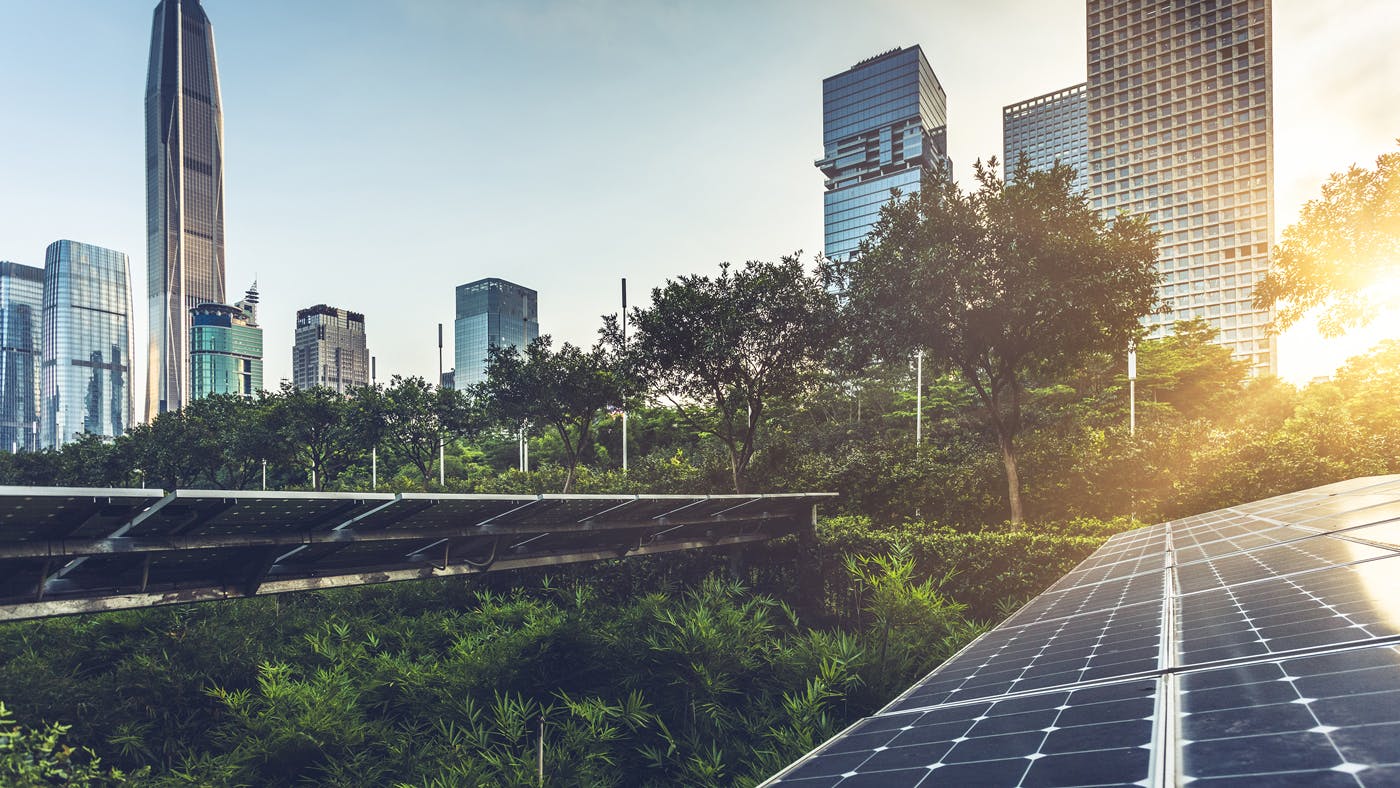Flash Note

5 minutes with… Michel Wiskirski, Carmignac Energy Transition Expert
- Published
-
Length
6 minute(s) read

Energy transition is all over the news. Our expert Michel Wiskirski explains the misunderstood truths about it.
What are the most misunderstood facts about energy transition?
Michel Wiskirski: Metals and mining are at the heart of climate fight. It is very important to understand that energy transition, by nature, is metal intensive. To put it simply, energy transition can’t happen without commodities and beyond that, a sustained growth in renewable energy is synonym of a quasi-exponential growth of metal usage and mining.
Can you give us a few examples from the energy generation side?
M. W.: Indeed, renewable sources of energy consume multiple times more minerals than traditional energy generation sources. A few numbers to highlight this: an onshore wind plant requires 8 times more minerals as a gas-fired plant of the same capacity. An offshore wind plant requires about 17 times more and a solar photovoltaic (PV) plant 9 times more. More specifically the energy transition metal by essence is copper. Copper intensity is massive. While it takes 1 ton of copper per megawatt (MW) for a natural gas fired power plant, it takes 2 tons for onshore wind, 3 tons for solar PV and in between 11 and 12 tons for offshore according to the latest numbers provided by the International Energy Agency. That same analysis applies to steel, zinc and other minerals.
I would also add that even in fossil fuel-based technologies, achieving higher efficiency and lower emissions relies on the extensive use of minerals. For example, the most efficient coal-fired power plants require a lot more nickel than the least efficient ones in order to allow for higher combustion temperatures.
Now if we turn to mobility and transportation, what would a wider use of electric vehicles require?
M. W.: If we look at traditional ICE (internal combustion engine) cars, one of the first climate fight was to reduce carbon dioxide and particles from car emissions. That has been done through upgrading the auto catalysts. In metal and mining terms, this has meant using much more abundant quantities of palladium and platinum.
An electric car uses five times as much minerals as a conventional car. Electric vehicles rely heavily on copper as well. Figures speak for themselves: a traditional combustion car is composed of 25kg. Electric vehicles on the other hand need on average three to four times as more copper around roughly 85kg. Additionally, the cabling for charging stations of electric vehicles will be another source of copper usage. To give you an idea, the demand for copper due to electric vehicles is expected to increase from 600 000 tonnes in 2021 to roughly 2.9 million tonnes by 20301. And where does the copper come from? Mining companies.
What about batteries for cars?
M. W.: The most common chemistries of battery electrodes rely on a combination of lithium, nickel, cobalt and manganese. The estimated material demand for the batteries of the electric vehicles sold in 2019 was about 19 kt for cobalt, 17 kt for lithium, 22 kt for manganese and 65 kt for nickel. For battery needs in the Stated Policies Scenario, cobalt demand expands to about 180 kt/year in 2030, lithium to around 185 kt/year, manganese to 177 kt/year and class I nickel to 925 kt/year.
So, renewable energies, electric vehicles, low carbon technologies are all undisputedly heavy consumers of metals – namely copper, steel, nickel, aluminium, cobalt, lithium and manganese. We favour those that stand to play an important role in the energy transition over the coming years.
Investing into renewables seem to be the solution to fight against global warming. However, is it enough to reach the net zero emission target we have set out for 2050?
M. W.: Renewables are a long-term solution for reducing emissions, but this is part of the answer to the problem. You cannot simply close your eyes and invest into renewables hoping to decrease emissions over time. The opposite will happen.
As a matter of fact, the development of renewable sources of energy is adding new emissions. Over the past few years, the production of gigawatts of solar PV and windfarms has increased CO2 emissions and not decreased them. We have just been running with 2 fixed costs systems, meaning 2 systems that emit more than what we had previously. We have produced more energy with more capacity that we have built.
So what would it take to meet the net zero and decarbonization targets? Is there something we are missing out to achieve our energy transition goals?
M. W.: The energy transition will take place over time and the companies that pollute the most will also be key players in reducing these emissions; through their decarbonisation but also through the climate change mitigation initiatives they will implement.
Over the past 50 years, a third of the world’s carbon dioxide emissions has come from only 20 companies – mainly world’s largest major oil and gas companies. Therefore, reducing carbon emissions aggressively and rapidly requires action on the side of those large emitters.
So what should we do as investors to contribute to energy transition?
M. W.: If we want to sizeably and efficiently reduce carbon emissions, both legs need to be addressed, financing not only companies developing renewables but also those diversified oil & mining companies, and through our investments encourage them to become big energy players with a better carbon footprint. The big players need to reduce their emissions and transition towards zero emissions and to invest in wind and solar energies, develop biofuels, carbon capture units, green hydrogen etc.
Big oil and big mining companies will have a big impact if they make efforts in terms of decarbonization. To exclude them would be a big mistake, would mean missing an opportunity to influence them.
Do you believe there is a case for investing in transitioning companies despite all the controversies surrounding them? Isn’t it against your responsible investment credentials?
M. W.: This is where we do things differently at Carmignac. Rather than restricting ourselves to the “best” students, those with zero or low carbon emissions, we also focus on companies with the highest reduction potential, within the most emitting segments. In other words, we invest not only in companies producing renewable energies and providing low carbon solutions but also the big key players that with their actions will enable drastic reduction in overall emissions.
We are investing in companies that show tangible intentions to improve CO2 and "decarbonization" in order to reach the goal of zero emissions by 2050.
How important is engagement for you?
M. W.: We want to use our active shareholder rights to work with companies to transition and therefore use this strategy to make a real impact, authentic, meaningful, that can really help the world transition to a lower carbon economy. Those companies devote dozens of billions of dollars to developing new sources of oil and gas. We, as shareholders, need to call for capital reallocation towards cleaner avenues of energy.
This enormous pool of capital and its allocation in the years to come will be critical in achieving carbon neutrality. Carbon neutrality will not happen without those players being committed and investors engaging with them to drive this change and achieve these decarbonization goals.
1Energy and metals research, Wood Mackenzie report 2021
Discover Carmignac Portfolio Green Gold
-
A sustainable equity fund acting for climate mitigation and energy transition
- Investing with a purpose: Aiming to generate attractive returns on the long-term while having a positive environmental contribution.
- Investing efficiently: Targeting innovative companies across the whole renewable and green industry value chains.
- Investing sustainably: Seeking to invest at least 60% of assets in companies whose activity contribute to climate change mitigation and climate change adaption according to EU taxonomy standards1.
SFDR2 Fund Classification: Article 9
1According to EU taxonomy standards.
2Since 15/05/2020. Sustainable Finance Disclosure Regulation (SFDR) 2019/2088. For more information please refer to EUR-lex.![[Main Media][Flash Note] Wind turbines [Main Media][Flash Note] Wind turbines](https://carmignac.imgix.net/uploads/article/0001/14/White_Paper_1400x788-thumb-article_mobile.png?auto=format%2Ccompress)
- Investing with a purpose: Aiming to generate attractive returns on the long-term while having a positive environmental contribution.
Carmignac Portfolio Climate Transition A EUR Acc
Recommended minimum investment horizon
Lower risk Higher risk
EQUITY: The Fund may be affected by stock price variations, the scale of which is dependent on external factors, stock trading volumes or market capitalization.
COMMODITIES: Changes in commodity prices and the volatility of the sector may cause the net asset value to fall.
CURRENCY: Currency risk is linked to exposure to a currency other than the Fund’s valuation currency, either through direct investment or the use of forward financial instruments.
DISCRETIONARY MANAGEMENT: Anticipations of financial market changes made by the Management Company have a direct effect on the Fund's performance, which depends on the stocks selected.
The Fund presents a risk of loss of capital.
Carmignac Portfolio Climate Transition A EUR Acc
| 2014 | 2015 | 2016 | 2017 | 2018 | 2019 | 2020 | 2021 | 2022 | 2023 |
2024 (YTD) ? Year to date |
|
|---|---|---|---|---|---|---|---|---|---|---|---|
| Carmignac Portfolio Climate Transition A EUR Acc | +7.86 % | -16.16 % | +21.68 % | +5.51 % | -17.70 % | +14.79 % | +4.51 % | +10.39 % | -15.09 % | +1.83 % | +10.06 % |
| Reference Indicator | -2.23 % | -19.66 % | +41.68 % | +5.15 % | -9.58 % | +18.78 % | -11.09 % | +27.54 % | -13.01 % | +18.06 % | +14.72 % |
Scroll right to see full table
| 3 Years | 5 Years | 10 Years | |
|---|---|---|---|
| Carmignac Portfolio Climate Transition A EUR Acc | -0.67 % | +2.55 % | +0.75 % |
| Reference Indicator | +9.06 % | +6.72 % | +4.46 % |
Scroll right to see full table
Source: Carmignac at 28/06/2024
| Entry costs : | 4,00% of the amount you pay in when entering this investment. This is the most you will be charged. Carmignac Gestion doesn't charge any entry fee. The person selling you the product will inform you of the actual charge. |
| Exit costs : | We do not charge an exit fee for this product. |
| Management fees and other administrative or operating costs : | 1,80% of the value of your investment per year. This estimate is based on actual costs over the past year. |
| Performance fees : | 20,00% when the share class overperforms the Reference indicator during the performance period. It will be payable also in case the share class has overperformed the reference indicator but had a negative performance. Underperformance is clawed back for 5 years. The actual amount will vary depending on how well your investment performs. The aggregated cost estimation above includes the average over the last 5 years, or since the product creation if it is less than 5 years. |
| Transaction Cost : | 0,32% of the value of your investment per year. This is an estimate of the costs incurred when we buy and sell the investments underlying the product. The actual amount varies depending on the quantity we buy and sell. |
